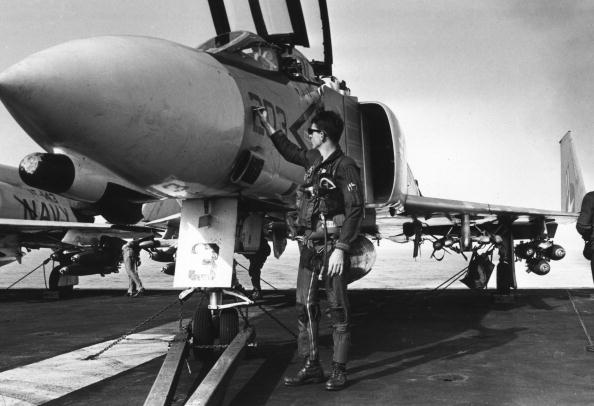
Think of it as the return of the Phantom.
Fly boys of a certain age perked up with reports Thursday that F-4 Phantom II’s belonging to the Iranian air force — or what’s left of it — have attacked targets belonging to the Islamic State of Iraq and Greater Syria (ISIS) in recent days.
The strikes, confirmed by U.S. officials (but denied by Tehran), took place northeast of Baghdad in eastern Iraq. Conveniently, the U.S. military, which is also conducting air strikes against ISIS targets, has been confining its bombing runs to the western part of the country.
If true, the Iranian attacks represent a return to the spotlight for the McDonnell Douglas F-4. The plane was originally designed for the Navy, which flew it first in 1960. It last flew for the U.S. military, specifically for the Air Force, in 1996 (it also was the only aircraft flown by both services’ airshow outfits, the Blue Angels and Thunderbirds).
The two-seat fighter-bomber was the backbone of U.S. air power in the 1970s and ’80s before being replaced by Air Force F-15s and F-16s, and Navy F-14s and F-18s. Capable of flying more than twice the speed of sound, the F-4 could carry nine tons of bombs and missiles. It is the last plane to carry pilots who became “aces” by shooting down five enemy aircraft each over Vietnam.
The U.S. built 5,200 F-4s and sold many of them to 11 nations. Iran bought 225 in the ’60s and ’70s under Shah Mohammad Reza Pahlavi, who was overthrown in 1979’s Islamic revolution. But the mullahs kept his jets (along with the 79 F-14 Tomcats the shah had also purchased).
Nearly all the surviving F-4s have been retired for decades at the Pentagon’s boneyard at Davis-Monthan Air Force Base in Arizona. But some have gotten a second lease on life as targets for more modern warplanes. Over the past 16 years, more than 300 have been converted into QF-4 aerial targets. They can be flown both with and without pilots, and are used to train air crews to detect aircraft with radar and other technologies.
These repurposed QF-4s have flown more than 16,000 manned and 600 unmanned training missions. About 250 of the unmanned missions have ended with Air Force pilots actually shooting the QF-4s out of the sky.
There are only 39 QF-4s still flying. But not to worry: they’re being replaced with QF-16s.
More Must-Reads from TIME
- Donald Trump Is TIME's 2024 Person of the Year
- Why We Chose Trump as Person of the Year
- Is Intermittent Fasting Good or Bad for You?
- The 100 Must-Read Books of 2024
- The 20 Best Christmas TV Episodes
- Column: If Optimism Feels Ridiculous Now, Try Hope
- The Future of Climate Action Is Trade Policy
- Merle Bombardieri Is Helping People Make the Baby Decision
Contact us at letters@time.com